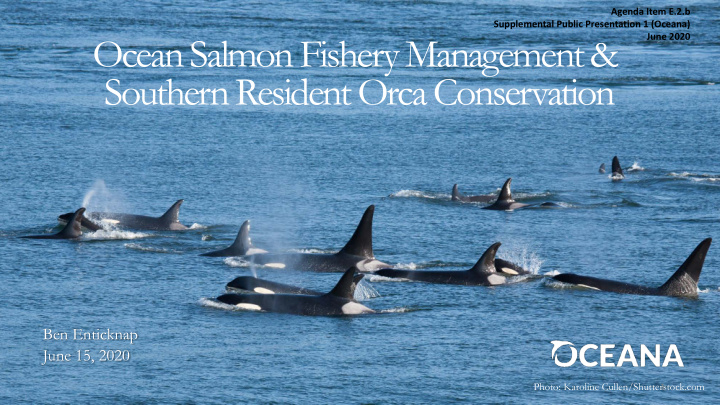



Agenda Item E.2.b Supplemental Public Presentation 1 (Oceana) Ocean Salmon Fishery Management & June 2020 Southern Resident Orca Conservation Ben Enticknap June 15, 2020 Photo: Karoline Cullen/Shutterstock.com 1
Southern Resident Extinction Risk is Increasing Southern Resident Killer Whales Fecundity rates have declined: (J,K,L pods) 100 69% of detectable pregnancies unsuccessful, linked to nutritional ESA-listing 95 # Southern Resident Killer Whales stress (Wasser et al. 2017) 90 At current threat levels, including 85 current average Chinook abundance, 80 there is a 59% probability that the population will drop below 30 animals 75 within 100 years, becoming functionally extinct (Lacy 2020, 70 72 update to Lacy et al. 2017 PVA 65 analysis). 60 Adapted from Center For Whale Research 2
Southern Resident Orcas need an Ocean Abundant with Chinook Salmon other other fish salmonids 1% 4% Coho 15% DIET COMPOSITION Chinook 80% 3
Quantifying the effects of prey abundance on killer whale reproduction - Ward, Holmes and Balcomb (2009) “killer whale fecundity is highly correlated with the abundance of Chinook salmon. For example, the probability of a female calving differed by 50% between years of low salmon abundance and high salmon abundance.” 4 Photo: NOAA
Prey Quality is Essential # Puget #Average Sound Chinook Chinook/ # Sacramento / day day Chinook/ day 1 adult Southern 12 to 20 17 to 30 10 to 18 Resident ( ♂ ) Pike Place Market, Seattle Over 34 years, between 1975 and 2009, Chinook shrunk on average 20% in weight and 7% in length.
“ Any activities that affect the abundance of Chinook salmon available to SRKW have the potential to impact the survival and population growth of the whales… and… Fisheries can reduce the prey available to the whales and, in some cases, can interfere directly with their feeding.” - PFMC Agenda Item E.5.b Supplemental NMFS Report 1 March 2020, at 18. Monika Wieland Shields /Shutterstock.com 6
Critical Ocean Proposed & Existing Southern Resident Habitat Killer Whale Critical Habitat “Most of the Chinook prey samples obtained while the whales were in outer coastal waters were determined to have originated from the Columbia River basin.” – NMFS 2019 SRKW Critical Habitat Proposed Rule
A precautionary approach is warranted Identify and implement a critical Chinook abundance threshold – similar in concept to the ‘cutoff’ factor for forage fish in the CPS FMP. • Develop a range of options for public review: the average of the lowest seven years of estimated ocean Chinook abundance North of Falcon (Threshold Option 1 ~ 970,000 Chinook), the maximum of the lowest seven years of estimated Chinook abundance North of Falcon (Threshold Option 2 ~ 1,000,000), and the maximum of the lowest ten years of estimated Chinook abundance North of Falcon (Threshold Option 3 ~ 1,100,000). 8
3,000,000 0 North of Falcon Chinook Abundance (TS1) & Recommended Abundance Threshold Options 2,500,000 Chinook Abundance 2,000,000 1,500,000 1,000,000 500,000 1992 1993 1994 1995 1996 1997 1998 1999 2000 2001 2002 2003 2004 2005 2006 2007 2008 2009 2010 2011 2012 2013 2014 2015 2016 Chinook Abundance Threshold Option 1 (970,000) Threshold Option 2 (1,000,000) Threshold Option 3 (1,100,000) 9
Daniel Bianchetta / Monterey Bay Whale Watch Recommendations Continued… • Consider a range of management measures for when Chinook abundance is below the threshold: • Reduced and limited Chinook catch limits, up to and including no ocean Chinook catch. • Time and area closures to avoid competition with Southern Residents. • Amend salmon FMP with an objective of managing and regulating salmon fisheries in a manner that accounts for the foraging needs of Southern Resident orca. Photo: USFWS
11 Monika Wieland Shields /Shutterstock.com
Recommend
More recommend